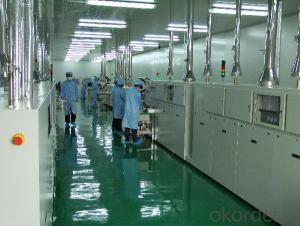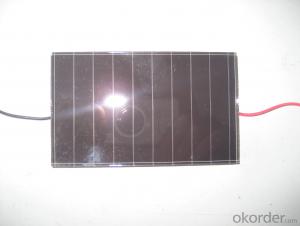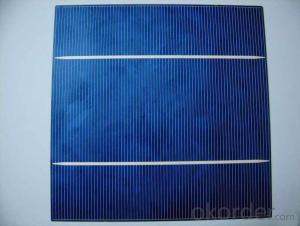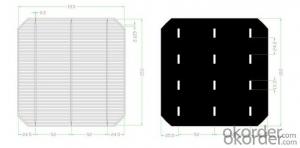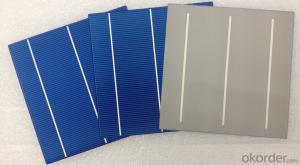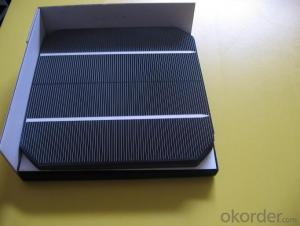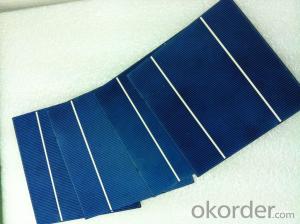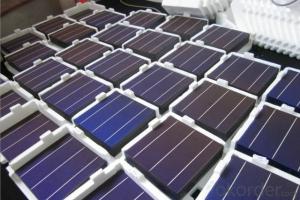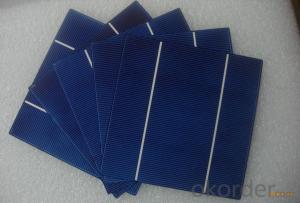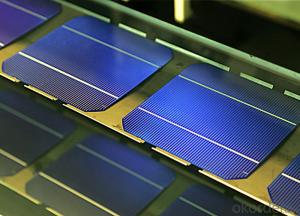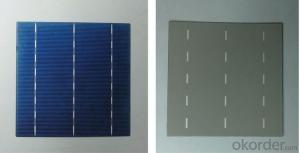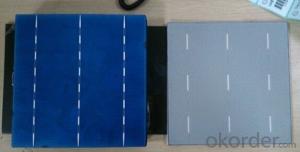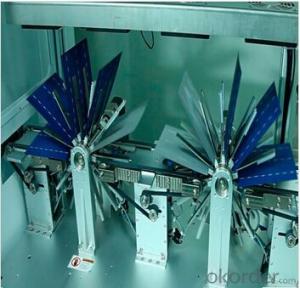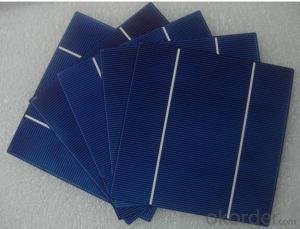Heterojunction Silicon Wafer Solar Cells - High Quality A Grade Polycrystalline 5V 15.6% Solar Cell
- Loading Port:
- Shanghai
- Payment Terms:
- TT OR LC
- Min Order Qty:
- 1000 pc
- Supply Capability:
- 100000 pc/month
OKorder Service Pledge
OKorder Financial Service
You Might Also Like
Specifications
hot sale solar cell
1.16.8%~18.25% high efficiency
2.100% checked quality
3.ISO9001/ISO14001/TUV/CE/UL
4.stable performance
We can offer you the best quality products and services, don't miss !
POLY6'(156*156)
Polycrystalline Silicon Solar cell
Physical Characteristics
Dimension: 156mm×156mm±0.5mm
Diagonal: 220mm±0.5mm
Thickness(Si): 200±20 μm
Front(-) Back(+)
Blue anti-reflecting coating (silicon nitride); Aluminum back surface field;
1.5mm wide bus bars; 2.0mm wide soldering pads;
Distance between bus bars: 51mm . Distance between bus bars :51mm .
Electrical Characteristics
Efficiency(%) | 18.00 | 17.80 | 17.60 | 17.40 | 17.20 | 16.80 | 16.60 | 16.40 | 16.20 | 16.00 | 15.80 | 15.60 |
Pmpp(W) | 4.33 | 4.29 | 4.24 | 4.19 | 4.14 | 4.09 | 4.04 | 3.99 | 3.94 | 3.90 | 3.86 | 3.82 |
Umpp(V) | 0.530 | 0.527 | 0.524 | 0.521 | 0.518 | 0.516 | 0.514 | 0.511 | 0.509 | 0.506 | 0.503 | 0.501 |
Impp(A) | 8.159 | 8.126 | 8.081 | 8.035 | 7.990 | 7.938 | 7.876 | 7.813 | 7.754 | 7.698 | 7.642 | 7.586 |
Uoc(V) | 0.633 | 0.631 | 0.628 | 0.625 | 0.623 | 0.620 | 0.618 | 0.617 | 0.615 | 0.613 | 0.611 | 0.609 |
Isc(A) | 8.709 | 8.677 | 8.629 | 8.578 | 8.531 | 8.478 | 8.419 | 8.356 | 8.289 | 8.220 | 8.151 | 8.083 |
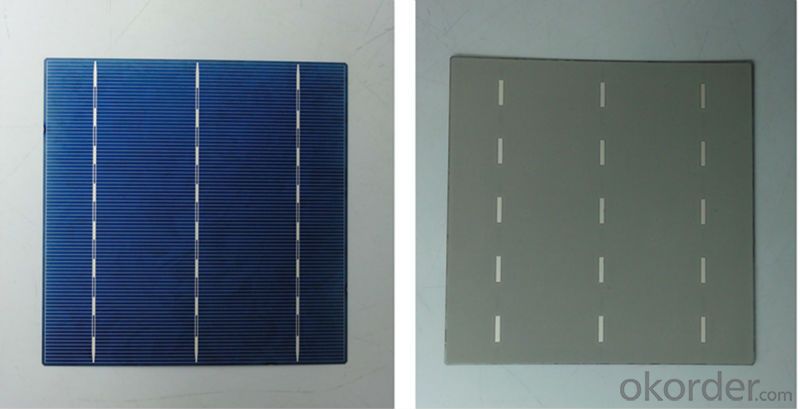
MONO5'(125*125mm)165
Monocrystalline silicon solar cell
Physical Characteristics
Dimension: 125mm×125mm±0.5mm
Diagonal: 165mm±0.5mm
Thickness(Si): 200±20 μm
Front(-) Back(+)
Blue anti-reflecting coating(silicon nitride); Aluminum back surface field;
1.6mmwide bus bars; 2.5mm wide soldering pads;
Distance between bus bars: 61mm . Distance between bus bars :61mm .
Electrical Characteristics
Efficiency(%) | 19.40 | 19.20 | 19.00 | 18.80 | 18.60 | 18.40 | 18.20 | 18.00 | 17.80 | 17.60 | 17.40 | 17.20 |
Pmpp(W) | 2.97 | 2.94 | 2.91 | 2.88 | 2.85 | 2.82 | 2.79 | 2.76 | 2.73 | 2.70 | 2.67 | 2.62 |
Umpp(V) | 0.537 | 0.535 | 0.533 | 0.531 | 0.527 | 0.524 | 0.521 | 0.518 | 0.516 | 0.515 | 0.513 | 0.509 |
Impp(A) | 5.531 | 5.495 | 5.460 | 5.424 | 5.408 | 5.382 | 5.355 | 5.328 | 5.291 | 5.243 | 5.195 | 4.147 |
Uoc(V) | 0.637 | 0.637 | 0.636 | 0.635 | 0.633 | 0.630 | 0.629 | 0.629 | 0.628 | 0.626 | 0.626 | 0.625 |
Isc(A) | 5.888 | 5.876 | 5.862 | 5.848 | 5.839 | 5.826 | 5.809 | 5.791 | 5.779 | 5.756 | 5.293 | 5.144 |

FAQ:
Q:How can i get some sample?
A:Yes , if you want order ,sample is not a problem.
Q:How about your solar panel efficency?
A: Our product efficency around 17.25%~18.25%.
Q:What’s the certificate you have got?
A: we have overall product certificate of ISO9001/ISO14001/CE/TUV/UL
- Q: How is the bandgap of a solar silicon wafer determined?
- The bandgap of a solar silicon wafer is determined through various experimental techniques, such as photoluminescence spectroscopy or optical absorption measurements. These methods involve shining light of different wavelengths onto the wafer and measuring the corresponding response, which helps determine the energy difference between the valence and conduction bands, known as the bandgap.
- Q: What is the typical reflectivity of a solar silicon wafer?
- The typical reflectivity of a solar silicon wafer is around 30% to 40%.
- Q: How does the efficiency of a solar silicon wafer change with temperature?
- The efficiency of a solar silicon wafer typically decreases with increasing temperature. This is because the electrical conductivity of silicon increases with temperature, leading to higher recombination rates and reduced electron-hole collection efficiency. Additionally, higher temperatures can cause an increase in the bandgap, resulting in a decrease in the number of photons absorbed by the wafer. These factors contribute to a decrease in the overall efficiency of the solar silicon wafer as temperature rises.
- Q: Are there any alternatives to using solar silicon wafers in solar cells?
- Yes, there are alternatives to using solar silicon wafers in solar cells. Some of these alternatives include thin-film solar cells made from materials such as cadmium telluride (CdTe), copper indium gallium selenide (CIGS), and organic photovoltaics (OPV). These alternative materials offer advantages such as flexibility, lightweight, and potentially lower manufacturing costs. However, their efficiency and stability still need further development to compete with traditional silicon wafers.
- Q: It is said that monocrystalline silicon, polycrystalline silicon wafer cutting requirements and problems are still quite a lot of
- 1, the impurity line caused by impurities in polycrystalline silicon ingot, slicing process can not completely remove the lead line on a silicon wafer.2, scratch line caused by mortar in large SIC particles or caking mortar. In the process of cutting, SIC particles stuck in between steel wire and silicon can not overflow, cause.Forms: including the whole line and half line marks, concave line, shiny, more narrow than the other.
- Q: What is the impact of impurities on the durability of solar silicon wafers?
- Impurities in solar silicon wafers can have a significant impact on their durability. These impurities can affect the structural integrity and electrical properties of the wafers, leading to reduced efficiency and shorter lifespan of the solar cells. Impurities like metal ions or oxygen can introduce defects in the crystal lattice, causing degradation and increased recombination of charge carriers. This can result in reduced power output and decreased overall performance of the solar panels. Therefore, minimizing impurities and ensuring high purity silicon is crucial for enhancing the durability and longevity of solar silicon wafers.
- Q: What is the impact of wafer surface quality on solar silicon wafer performance?
- The impact of wafer surface quality on solar silicon wafer performance is significant. A high-quality surface ensures better light absorption, improved electron mobility, and reduced recombination of charge carriers. This leads to higher efficiency and overall performance of the solar cell. Conversely, a poor surface quality can result in reduced light absorption, increased electron recombination, and lower overall efficiency. Therefore, achieving and maintaining a high-quality wafer surface is crucial for optimizing the performance of solar silicon wafers.
- Q: How are solar silicon wafers etched to enhance light absorption?
- Solar silicon wafers are etched using various techniques, such as chemical etching or texturization, to enhance light absorption. This involves creating a rough surface on the wafer, which helps to reduce reflection and increase the amount of light that is absorbed by the silicon material. By etching the wafer, the surface area is increased, allowing for more interactions between incoming light and the silicon, ultimately improving the efficiency of the solar cell.
- Q: Are solar silicon wafers affected by electromagnetic waves?
- Yes, solar silicon wafers can be affected by electromagnetic waves. Electromagnetic waves can induce currents within the silicon material, causing interference and reducing the efficiency of solar panels. However, solar panels are designed to minimize these effects and are often shielded to mitigate electromagnetic interference.
- Q: How do solar silicon wafers perform in dusty environments?
- Solar silicon wafers can experience reduced performance in dusty environments due to the accumulation of dust particles on their surface. Dust can block sunlight and create a barrier between the wafer and the sunlight it needs to generate electricity. This can lead to a decrease in the efficiency of solar panels and a reduction in their overall power output. Regular cleaning and maintenance of solar panels in dusty environments is essential to ensure optimal performance.
Send your message to us
Heterojunction Silicon Wafer Solar Cells - High Quality A Grade Polycrystalline 5V 15.6% Solar Cell
- Loading Port:
- Shanghai
- Payment Terms:
- TT OR LC
- Min Order Qty:
- 1000 pc
- Supply Capability:
- 100000 pc/month
OKorder Service Pledge
OKorder Financial Service
Similar products
Hot products
Hot Searches
Related keywords
